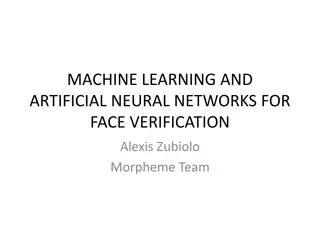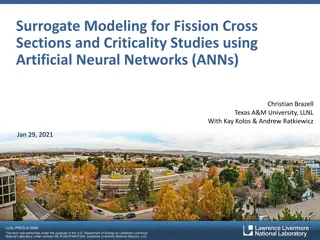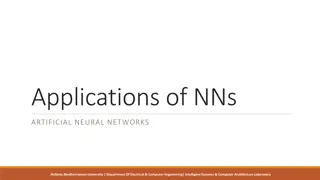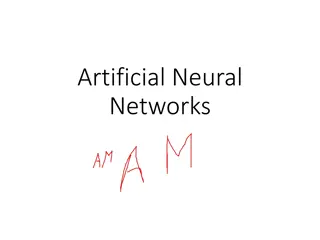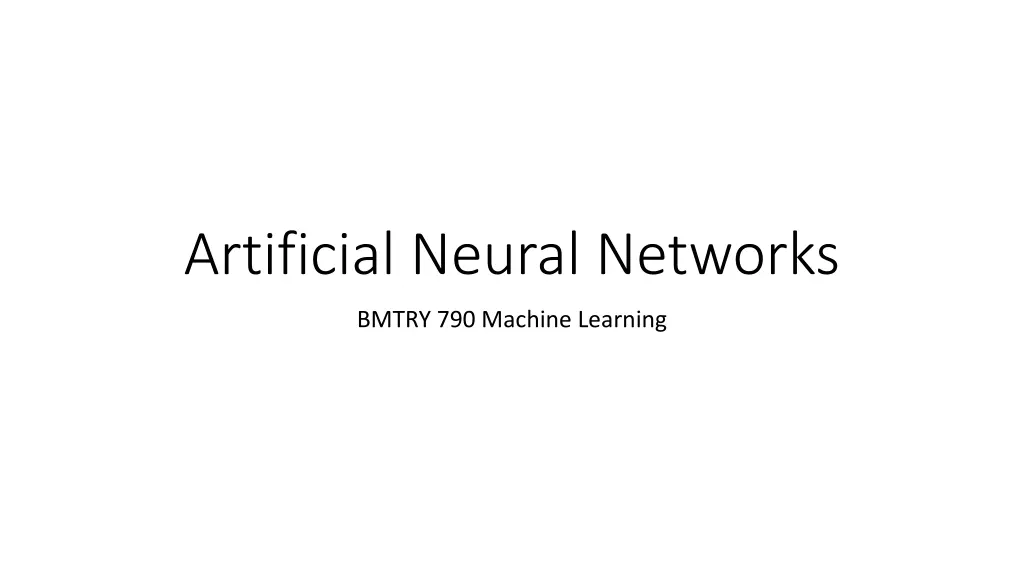
Understanding Artificial Neural Networks and Neural Inspired Computing
Delve into the world of artificial neural networks, their non-linear functionalities, and the biological inspiration behind them. Explore the fascinating comparison between brains and computers in terms of processing power and energy efficiency.
Download Presentation

Please find below an Image/Link to download the presentation.
The content on the website is provided AS IS for your information and personal use only. It may not be sold, licensed, or shared on other websites without obtaining consent from the author. If you encounter any issues during the download, it is possible that the publisher has removed the file from their server.
You are allowed to download the files provided on this website for personal or commercial use, subject to the condition that they are used lawfully. All files are the property of their respective owners.
The content on the website is provided AS IS for your information and personal use only. It may not be sold, licensed, or shared on other websites without obtaining consent from the author.
E N D
Presentation Transcript
Artificial Neural Networks BMTRY 790 Machine Learning
Non-Linear Separation We started the class with a discussion of linear separation boundaries Linear classifiers LDA Logistic Regression Hyperplane Many of the methods we ve discussed relax (or eliminate) this idea Neural Networks are another method to move beyond linearity
Nonlinear Test Statistics The optimal decision boundary may not be a hyperplane H1 H0 accept Multivariate statistical methods are a Big Industry: Splines MARS and GAMS Decision trees and ensemble And now we add ANNs
Artificial Neural Networks (ANNs) Central Idea Extract linear combinations of inputs as derived features and then model the outcome (classes) as a nonlinear function of these features What does that mean? We will see shortly they are nonlinear statistical models but with pieces that are familiar to us already
Biologic Neurons Idea for Neural Networks came from biology- more specifically, the brain Input signals come from the axons of other neurons, connect to dendrites (input terminals) at the synapses If a sufficient excitatory signal is received, the neuron fires and sends an output signal along the axons The firing of the neuron occurs when a threshold excitation is reached
Brains versus Computers : Some numbers Brains versus Computers : Some numbers Approximately 10 billion neurons in the human cortex, compared with 10 of thousands of processors in the most powerful parallel computers Each biological neuron is connected to several thousand other neurons, similar to the connectivity in powerful parallel computers Lack of processing units can be compensated by speed. The typical operating speeds of biological neurons is measured in milliseconds while a silicon chip can operate in nanoseconds The human brain is extremely energy efficient, using approximately 10-16 joules per operation per second, whereas the best computers today use around 10-6 joules per operation per second Brains have been evolving for tens of millions of years, computers have been evolving for tens of decades.
Mathematical Model of a Neuron Non-linear (mathematical) models of an artificial neuron x1 x2 w1 w2 x3 h w3 g O Output signal Activation/ Threshold Function wp Synaptic Weights xp Input Signal
Original ANNs ANNs are based on simpler classifiers called perceptrons The original single layer perceptron used the hard threshold (sign function) but this lacks flexibility making separation of classes difficult Later adapted to use the sigmoid function Note this is familiar (think logistic regression) ANNs are adaptation of the original single layer perceptron that include multiple layers (and have hence also been referred to as multi-layer perceptrons) Use of the sigmoid function also links it with multinomial logistic regression
Artificial Neural Networks (ANNs) ANNs modeled after the brain so often refer to features/outputs as neurons ANNs consist of (1) A set of observed input features (2) A set of derived features (3) A set of outcomes we want to explain/predict (4) Weights on connections between inputs, derived features, and outcomes The simplest (and perhaps most common) type of ANN is a feed-forward ANN This means data feed forward through the network with no cycles or loops
Diagram of an ANN Neural Network is 2-stage classification (or regression) model Y1 Y1 Y2 YK Can be represented as network diagram for classification these represent the K-classes kth unit models probability of being in kth class Z1 Z2 Z3 ZM X1 X2 X3 Xp-1 Xp
Parts of an ANN Using this generic example Y1 Y1 Y2 YK (1) Xi , i=1,2, , p are the observed features/inputs (2) Zm , m=1,2, , M, are the derived features linking X and Y -referred to as the hidden layer Z1 Z2 Z3 ZM X1 X2 X3 Xp-1 Xp (3) Yk , k=1,2, ,K, are the outputs -Classification: classes we want to model using observed features X -Regression: Ycould be a continuous
Hidden Layer for ANN Hidden Layer Zmrepresent hidden features derived by applying an activation function to linear combinations of the observed features Y1 Y1 Y2 YK ( ) ( ) v = = + = ' m , 1,2,..., Z m M X Z1 Z2 Z3 ZM 0 m m Common activation functions include Sign function Sigmoid function Radial basis function X1 X2 X3 Xp-1 Xp
More on Activation Functions The activation function, , could be any function we choose In practice, there are only a few that are frequently used 1 if 0 if 0 0 x x ( ) i sign x ( ) = 1 e ( ) ii sigmoid x ( ) = + x 1 ( ) iii Gaussianradialbasis function
Output from ANN Output Output Outputs (i.e. predicted Y s) come from applying a non-linear function to linear combinations of derived features Zm Y1 Y1 Y2 YK = = + = ' k 1 2 , ,...,K T Y Z, k Z1 Z2 Z3 ZM 0 k k ( ) X ( ) = f g T k k Some examples of gk(T) X1 X2 X3 Xp-1 Xp ( ) ( ) ( ) v = = Tk K = softmax useif g T sigmoid e k Tk e 1 l ( ) ( ) = identity use for regression ANNs g T T k k
A Little Mode Detail Consider the expression for the derived features Zm ( 0 m m Z = + X ) = ' m 1 2 , ,...,M , m Parameters 0mrepresent bias Not statistical bias We discussed similar concept for LDA bias defines location of a decision boundary Parameters m define linear combinations of X s for derived features Zm and can be thought of as weights i.e. how much influence a particular input variable Xi has on the derived feature Zm
A Little More Detail Now consider the expression for the output values Yk = + Z ' k T 0 k k ( ) ( ) = = + = ' k 1 2 , ,...,K Y g T g , k Z 0 k k k k k Parameters 0krepresent another bias parameter These also help define locations of decision boundaries Parameters k define linear combinations of derived features Zm also represent weights i.e. how much influence a particular derived feature Zm have on the output We can add these weights into the graphic representation of our ANN
Y1 Y1 Y2 YK 1M 21 3M K1 11 13 22 23 KM 12 K2 K3 Z1 Z2 Z3 ZM 21 11 3p Mp X1 X2 Xp X3 Xp-1
Simple Example of Feed-Forward ANN Consider a simple example: 4 input variables (i.e. our Xi s) 3 derived features (i.e. our Zm s) 2 outcomes (i.e. our Yk s) Let s look at the graphic representation of this ANN
Simple Example of Feed-Forward ANN Three derived features in the hidden layer: Z1, Z2, and Z3 X1 Z1 Y1 Y1 X2 Two outputs: Y1 and Y2 (i.e. possible classes in the data) Z2 Y2 X3 Z3 X4 Four inputs: X1, X2, X3, and X4 (i.e. observed features in the data)
Simple Example of Feed-Forward ANN 11 X1 First consider the connection between observed features X and derived features in the hidden layer, Z1, Z2, and Z3 12 13 Z1 21 Y1 Y1 22 X2 23 ( ) Z2 = + X ' Z 31 0 m m m Y2 32 X3 33 We can add the weights for each of the X s for the derived features to our graphical representation Z3 41 42 43 X4
Simple Example of Feed-Forward ANN Consider the first derived feature Z1 11 X1 It is created by applying our activation function, , to a linear combination of out observed features Z1 12 Y1 Y1 Say the activation function is sigmoid it takes the form ( ) 1 e + X2 13 1 Z2 = x x Y2 X3 What does derived feature Z1 look like (i.e. what is the functional form?): 14 Z3 X4
Simple Example of Feed-Forward ANN Given the form of the activation function, it is easy to write out the form of each of our three derived features Z1, Z2, and Z3
Simple Example of Feed-Forward ANN X1 Now that we have the form of our derived features, Z1, Z2, and Z3, we can now consider the connections between our derived features and out outputs Yk 11 Z1 12 Y1 Y1 X2 21 = + = ' k , 1,2,..., T k K Z Z2 0 k k = 22 ( ) ( ) X ( ) = + ' k f g T g Z 0 k k k k k Y2 X3 31 Again we can add the weights to the graphical representation of our ANN 32 Z3 X4
Simple Example of Feed-Forward ANN Consider the first output class Y1 X1 11 It is created by applying an output function, gk(T), to a linear combination of the derived features Z1 12 Y1 Y1 X2 Since the activation function is sigmoid, it makes sense for the our output function to be the softmax function 21 Z2 22 Y2 T X3 e k ( ) T = g 31 k K T e k = 1 32 l Z3 So what form does our first output Y1 take? X4
Simple Example of Feed-Forward ANN Given the form of the output function, it is easy to write out the form of the two outputs Y1 and Y2
Feed-Forward ANN Denote complete set of weights, , for the ANN as 0 , ; 1,2,..., k k k = ( ) = + , ; 1,2,..., 1 weights m M M p 0 m m ( ) + 1 weights K K M Goal: Estimate weights such that the model fits well Fitting well means minimizing loss function or error For regression can use sum-of-squared error loss ( ) 1 k R = ( ) ( ) x 2 K N = y f ik k i = 1 i For classification we can use either the sum-of squared error or the deviance (also known as cross-entropy) ( ) 1 1 log ik i k R y = = ( ) = ( ) x N K f k i
Fitting a Feed-Forward ANN Purpose of learning is to estimate parameters/weights for connections in the model (i.e. m and k) that allow model to reproduce the provided patterns of inputs and outputs ANN learns function of arbitrary complexity from examples (i.e. the training data) Complexity depends on the number of hidden neurons Once network trained can use it to get the expected outputs with incomplete/slightly different data
Fitting a Feed-Forward ANN Basic idea of the learning phase: Back Propagation for learning the parameters/ weights in a feed- forward ANN (one method) Provide observed inputs and outputs to the network, Calculate estimated outputs Back propagating the calculated error Repeat process iteratively for a specified number of iterations Under back propagation, weights are updated using the gradient descent method Follow steepest path of error function in order to minimize it
Illustration of Gradient Descent R( ) w1 w0
Illustration of Gradient Descent R( ) w1 w0
Illustration of Gradient Descent R( ) w1 Direction of steepest descent = direction of negative gradient w0
Illustration of Gradient Descent R( ) w1 Original point in weight space New point in weight space w0
Back Propagation (1) Initialize weights with random values (generally (1,-1)) (2) For a specified number of training iterations do: For each input and ideal (expected) output pattern i. Calculate the output from the input ii. Calculate output neurons error iii. Calculate hidden neurons error iv. Calculate weights variations (delta) v. Adjust the current weight using the accumulated deltas (3) Iterate until some chosen stopping point
Back-Propagation using Gradient Descent i. Calculate the actual output from the input (rth iteration)
Back Propagation Using Gradient Descent ii. Calculate output neurons error iii. Calculate hidden neurons error Based on out choice of model fit/error function (e.g. SSE) 2 ( ) ( ) N K = y R y ik ik = = 1 1 i k Write in terms of the weights .
Back-Propagation using Gradient Descent Goal is to minimize the error term so take the partial derivative with respect to the weights This must be done of each weight in the ANN Start with the weights in our hidden layer variables
Back-Propagation Using Gradient Descent For SSE Use chain rule and write in terms of predicted y, Tk, and then km
Back-Propagation Using Gradient Descent Repeat this idea for the input weights
Back Propagation Using Gradient Descent ii. Calculate output neurons error -this comes from the derivative of the hidden layer weights iii. Calculate hidden neurons error -this comes from the derivative of the input weights
Back Propagation iv. Calculate weights variations (delta) -Just the derivatives of our error function with respect to the weights For hidden layer/derived features R y ( ) ( ) = y y y 2 1 i z ik ik ik ik mi km For the input features R ( ) ( ) ( ) K = km mi z y y y 1 1 i y z x ik ik ik ik mi ij = 1 k mj ( ) ( ) ( ) K = km mi z y y y 1 1 s y z mi ik ik ik ik mi = 1 k
Learning Rate We also want to scale the step sizes the algorithm takes This scale value is also known as the learning rate and controls how far we descend on the gradient In general it is a constant selected by the user This learning rate, r, is multiplied by the derivatives
Update at the r+1 Iteration v. Add the weights variations to the accumulated delta R R ( ) ( ) r km ( mj ) ( ) r mj N N + + 1 1 r r = = & i i ( ) r km ( ) r mj km r r = = 1 1 i i = = 1,2,..., 1,2,..., 1,2,..., 1,2,..., = number observations number inputs number hidden units number classes i N p j = m k M K
Back Propagation In forward pass current weights fixed and predicted values come from these weight In backward pass errors are estimated and used calculate the gradient to update the weights Learning rate r often taken to be fixed though it can be optimized to minimize the error at each iteration One important note, since the gradient descent algorithm requires taking derivatives, the activation, output, and error functions must be differentiable w.r.t. the weights
Deep Learning Deep learning: Class of algorithms using multiple layers to extract progressively higher level features from original input features in X Each layer transforms input features in to a slightly more abstract representation Many deep learning models based on neural networks So far we ve only described an ANN with a single hidden layer Deep neural nets are defined as such due to use of multiple hidden layers Additional hidden layers intuitively expected to be more powerful
Deep Neural Networks The main distinction between ANNs discussed up to now and deep NNs is the number of hidden layers Deep NNs have multiple hidden layers between the input and output layers >3 layers constitutes a deep neural network Architecture of DNN can be thought of as a compositional model in which the output is expressed as a layered composition of primitives Each layer of nodes is trained in the distinct features from the previous node
Diagram of a DNN 1st Hidden Layer kth Hidden Layer Input Layer . . . . . . Output Layer . . .
Deep Neural Networks Feed forward DNN similar to an ANN with a single hidden layer: 1st hidden layer is a weighted combination of original inputs Output from 1st hidden layer = derived features based on applying activation function to the weighted combination of inputs Generate 2nd hidden layer as weighted combination of the derived features from the 1st hidden layer Repeat for m hidden layers Output Y is posterior probability/mean determined by applying appropriate link function
Training Feed Forward DNNs Weights can be determined at each layer using stochastic gradient descent by back propagation Using this approach does not necessarily improve prediction performance There is an intrinsic instability in using stochastic gradient descent in DNNs Vanishing gradient problem: gradient gets smaller moving backward through the hidden layers Exploding gradient problem: gradient gets larger moving backward through the hidden layers
Vanishing/Exploding Gradient Problem Consider a simple DNN w4 w1 w2 w3 Z1, b1 Z3, b3 Z2, b2 Z3, b4 X Y The wj s are s/ s from single hidden layer ANN and bj s are the bias (recall this is the intercept term) Recall to solve gradient descent we used the chain rule: ??? ???? =??? ? ??? ? ??? ??? ??? ????




